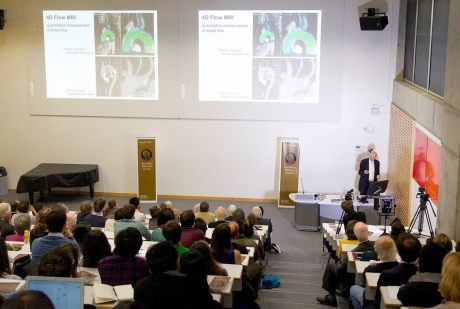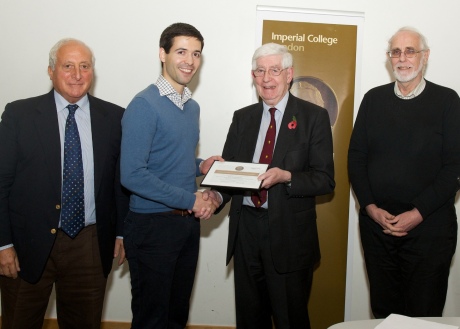
Imperial Provost Professor James Stirling handing Professor Jurgen Hennig the Hounsfield medal.

Imperial staff and students welcomed chemist and medical physicist Professor Jürgen Hennig to Imperial for the annual Hounsfield Lecture.
The Hounsfield Memorial Lecture brings together medical imaging researchers at Imperial and beyond and allows an international leader in biomedical imaging to address the College imaging community.
The Hounsfield Lecture 2015 was given on Wednesday 4th November by Professor Juergen Hennig from the University Medical Center Freiburg. Professor Hennig is a German chemist and medical physicist, internationally renowned for his work as one of the pioneers of Magnetic Resonance Imaging for clinical diagnostics. He is an alumnus of Imperial and also studied at the Universities of Stuttgart, Munich and Freiburg, where he currently works as Scientific Director of the Department of Diagnostic Radiology and Chairman of the Magnetic Resonance Development and Application Center. His awards include the Biosciences and Medicine Max Planck Research Award (2003), the highest scientific award of Taiwan - Tsung Ming Tu Award (2010), and an Einstein professorship from the Chinese Academy of Science (2011).

Professor Hennig giving the lecture
Professor Hennig talked about current innovations in Magnetic Resonance Imaging (MRI), which has been around for more than 30 years, but is still undergoing rapid development. This progress is being driven by innovative technologies as well as new challenges and opportunities arising from new advancements in biomedical research. The introduction of new technologies is expected to lead to incremental improvements in current approaches to MRI, as well as new applications.
Although MRI has come a long way since its early stages, it still has far to go.
Poster competition and workshops
The event also featured workshops in the afternoon and a medical imaging poster viewing event and competition.
Four interactive workshops were organised, including:
- Imaging for Global Health
- Big Data @ Small Scales
- Magnetic Resonance Imaging and Atrial Fibrillation Ablation Studies
- Patient-specific-computational-fluid-dynamics
The winning poster was:
High resolution 3D MRI reveals continuous adverse effects of systolic blood pressure on left ventricular structure
by Antonio de Marvao from the MRC Clinical Sciences Centre.

Winner Antonio de Marvao from the MRC Clinical Sciences Centre
The joint runners-up were:
Investigating the Causal Relationship Between Perturbed Shear Stress and Formation of Progressive Atherosclerotic Plaques and Thin Cap Fibroatheroma in Transgenic Hypercholesterolaemic Minipigs
and
Tractography of the Prostatic Neurovascular Bundles: Technique and Interpretation
Photos from the event can be viewed on our Flickr pages here.
Article text (excluding photos or graphics) available under an Attribution-NonCommercial-ShareAlike Creative Commons license.
Photos and graphics subject to third party copyright used with permission or © Imperial College London.
Reporter

Jo Seed
Institute of Global Health Innovation

Contact details
Email: press.office@imperial.ac.uk
Show all stories by this author



